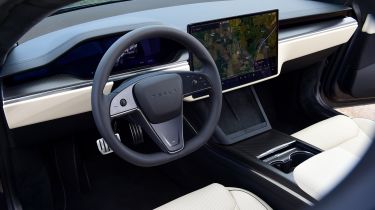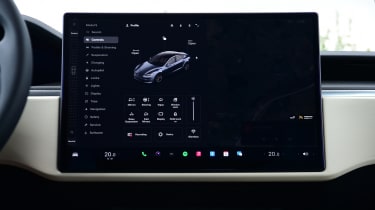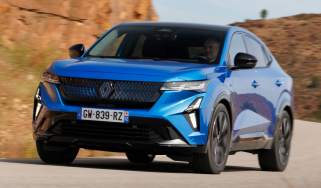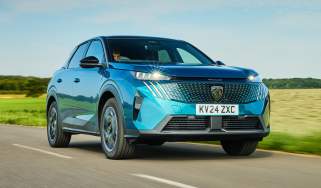Tesla Model S review - Interior, design and technology
Build quality has taken some big steps forward, while tech in the Model S remains on the cutting edge

The styling of the Model S has slowly evolved over the past decade-and-a-bit it's been around, but its low-slung and svelte shape hasn’t changed and it’s not a bad-looking car. Its wide haunches and sweeping roofline help give it a sporty stance on the road, especially when combined with the optional 21-inch alloy wheels. Plaid models receive some upgraded bodywork, rear diffuser, carbon-fibre bootlid spoiler and unique badging.
However, it’s inside that Tesla’s different approach hits home, and it’s even more emphatic in the latest model with its all-new interior. Pull on the pop-out door handles and the first thing you’ll probably notice is the enormous 17-inch touchscreen in the centre of the dash, followed by hardly any buttons. The few left are a gear selector and a hazard warning switch located below the wireless charging pad.
The Model S also gets a TFT screen in the instrument cluster pod set in front of the driver, plus a screen for the rear passengers to control the temperature in the back. In terms of entertainment, it might not feature anything like Mercedes’ ‘Hyperscreen’ infotainment set-up, or the BMW i7’s 31-inch 8K Theatre Screen, but the Model S can stream movies and TV shows on Netflix (only when you’re parked, mind you) and has plenty of games to choose from in the ‘arcade’. There’s the Tesla’s toy box too, which includes ‘emissions’ and ‘romance’ modes.
Only Tesla could stir up controversy about a steering wheel, but it managed to do just that after the updated Model S launched exclusively with a steering yoke. It’s a feature that’s starting to show up more and more in new EVs, including the Lexus RZ SUV and MG Cyberster two-seater, however Tesla now gives buyers a choice of the yoke or a conventional round steering wheel.
Used - available now

2016 Tesla
Model S
69,380 milesAutomaticElectric
Cash £27,800
2016 Tesla
Model S
55,600 milesAutomaticElectric
Cash £17,743
2016 Tesla
Model S
110,000 milesAutomaticElectric
Cash £17,500
2013 Tesla
Model S
6,800 milesAutomaticElectric
Cash £22,999You still don’t get any physical buttons on either, just two scroll wheels for adjusting the volume, and touch-sensitive panels to control the wipers and lights. Even the indicator switches are now on the steering wheel, which don’t do the user experience any favours.
Build quality was never the Model S’s strong suit, in fact it has long been one of the car’s biggest failings. Thankfully Tesla has taken some very welcome steps in the right direction, and we found most of what you touch inside seems worthy of this car’s circa-£100,000 price tag, although the cutting-edge tech and awe-inspiring speeds also helps with that. Admittedly, some of the external panel gaps are still a bit large for our liking, but it’s better than it used to be.
You can’t custom order a new Tesla Model S (or Model X) in the UK at the moment. Instead you pick from the available inventory of new cars, although there are plenty to choose from, all ready to be delivered. There’s not a huge options list to choose from with the Model S, just five exterior paint colours and three interior colour schemes: black, white and cream. As well as the choice of steering wheels and standard or Plaid models, buyers can also add Tesla’s full Autopilot system.
Standard kit includes the three aforementioned screens, a 22-speaker, 960-watt sound system with Active Road Noise Reduction, 19-inch alloy wheels, wireless charging pads in the front and back and a suite of driver assistance tech.
Sat-nav, stereo and infotainment
The Tesla Model S set a new benchmark for interior technology when it first launched, and the updated model is even better. The big change is the new 17-inch central touchscreen, which is now landscape rather than portrait, can be tilted more towards the driver or front passenger, and is as sharp and precise as an iPad. There’s no Apple CarPlay or Android Auto, but you can download some apps straight to the car that give you access to services such as Spotify on the go.
Tesla also uses Google Maps for its sat-nav, so it’s familiar and easy to use. You either follow instructions on the touchscreen or have them displayed within the high-definition instrument panel. Speaking of which, you get information about whether you have cars, bikes and even pedestrians in your blind spot via the driver’s display.
But the touchscreen is responsible for so much more than your navigation and music – you rely on it for almost all of the car’s main functions, including the lights and wipers, with the latter buried within the car’s menus. Thankfully Tesla’s system features big icons and a relatively logical layout eases some of our frustrations.










